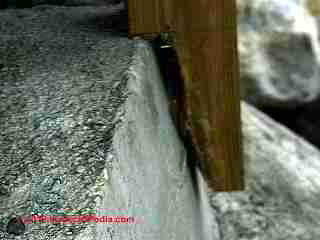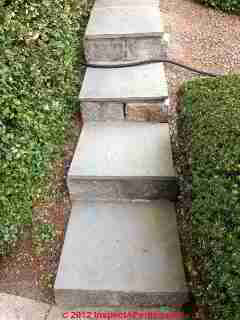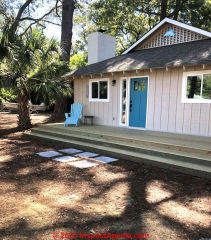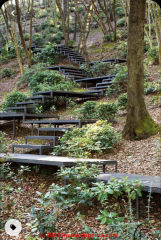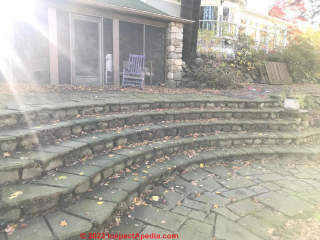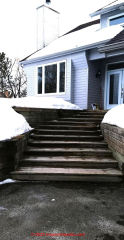 Exterior Stairways: Guide to Outdoor Stair, Railing, Landing Construction Codes & Hazard Inspection
Exterior Stairways: Guide to Outdoor Stair, Railing, Landing Construction Codes & Hazard Inspection
- POST a QUESTION or COMMENT about Exterior Stair Code Specifications & Construction
Exterior stairway construction details & suggestions for safe stairways:
Here we give photos, and examples of defects found in inspecting indoor or outdoor stairs, railings, landings, treads, and related conditions for safety and proper construction.
We include references to stair code articles cataloging the causes of stair slips, trips, and falls and to building code specification details for proper stair, landing, balcony and railing construction.
InspectAPedia tolerates no conflicts of interest. We have no relationship with advertisers, products, or services discussed at this website.
- Daniel Friedman, Publisher/Editor/Author - See WHO ARE WE?
Exterior Stair Code Specifications & Construction Recommendations
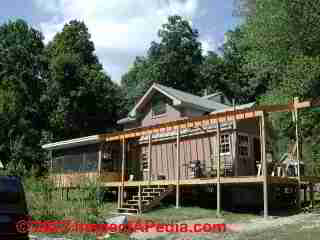 A stair inspection checklist provided in this document outlines information to collect during a field investigation
of the condition of an interior or exterior stairway for safety defects.
A stair inspection checklist provided in this document outlines information to collect during a field investigation
of the condition of an interior or exterior stairway for safety defects.
While in general the building code specifications for exterior stairs, landings, and railings are the same as for indoor star is, we often see special trip hazards at exterior stairs and walks, conditions that do not occur indoors, and details which may escape some building inspectors.
Photo: stairs along this new front deck have bottom newell posts but no handrails - unsafe and not complying with building codes for stairs. Perhaps work on the porch and stairs was simply incomplete at the time of our photo.
[Click to enlarge any image]
When we encounter steps and a deck such as the version shown in our photo (above left) we are confident that the construction was done without the benefit of building permits and code approvals, is unsafe, and may harbor other hidden structural or safety hazards.
And some stair design requirements, such as stair treads that will not hold water, naturally pertain principally to outdoor stairways.
We add some more subtle warnings about outdoor stairs and stair construction, and tips or tricks of carpentry and masonry to avoid problems with stairs.
Construction Requirements for Safe Outdoor Steps, Stairs, Railings, Newel Posts
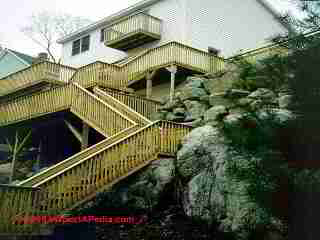
- Proper structural support for the stair assembly
is critical to avoid catastrophic failures and serious injuries.
Our two stair photos just above and below show a large, complex exterior stair built along a rocky hillside - more of a cliff. The lack of connection of supporting posts to piers below this stair was appalling.
See details at NEWEL POST CONSTRUCTION
- Proper exterior stair tread drainage:
Outdoor stairs should be designed so as not to accumulate water on the tread surface Wet stair tread surfaces become slippery from water, ice, or algae and fungal growth.
Watch out: as we detail at EXTERIOR STAIR FALLS, algae, ice, snow and water make outdoor stairs very slippery and dangerous.

- Wooden stair treads should be installed with the end grain curve "down" vs "up": which way?
Notice the end-grain of boards to be used as stair treads, and make sure that when building a wooden outdoor stair tread you place the tread boards with the "bark side" down - the wood grain visible at the end of stair tread boards should arc down.
The image shown at left, courtesy S. Bliss, Best Practices in Residential Construction, depicts the end grain of wooden deck boards stair treads as they would appear if you had placed the bark side down.
The bark side of lumber determines the natural curvature of the tread board as the wood dries, and it makes for the best stair tread drainage and the minimum cupping or or holding of water on the stair tread. But which way is right: bark side up or bark side down. - Not all carpenters agree with this sketch
as shown here and would have flipped these boards (or stair treads over).
Details about this construction safety tip are at BARK SIDE UP on DECKS & STEPS. There we include this additional warning:
Watch out: On wooden decks and stair treads, a defect shelling can occur with the bark side down method. Shelling is a term used by some builders to refer to the loss of portions of a board surface as late wood growth (the outer surface of the tree and thus the "bark side" of the board) separates from early wood growth (the inner portion of the tree or the tree-center side of the board). - If after construction a deck or stair tread board misbehaves
and cures with a concave cup that will tend to hold water (and form algae, ice and slip hazards such as discussed at SLIPPERY STAIRS, WALKS, ROOFS), drill small drainage holes in the center of the cupped board.
Make sure the drain holes won't catch a high-heeled shoe by making them small or locating them out of the walking path.
Exterior Stairs - Incomplete, Unsafe, Missing Guardrails

The exterior stair shown above appears to have been installed as a fire-exit way, but lacks a guardrail around the stair top balcony. It is exactly during an emergency that a frightened user is more likely to fall at this location.
Safety & design questions for sloped, pitched, & narrow exterior masonry steps
Reader Question:
My mother is elderly and is moving from her home to a co-op building. Her unit is on the first floor and her patio is served by an outdoor staircase made of flagstone steps.
There is a steep incline to the steps, and they seem to be too narrow for the incline. We have asked the board of the co-op if we can widen each step from their current width of 23 1/2 inches to 30 inches.
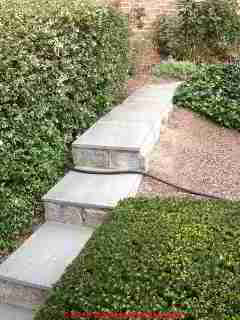
The board is opposing our request to widen the steps on aesthetic grounds, and not considering my mother's safety. They are allowing us to rebuild the staircase, as it was poorly built to begin with.
Is there a way to determine what the proper width of each flagstone should be (side to side) based on the incline of the staircase?
What I would like to do if possible is to show the board from a mathematical standpoint what the proper width of the steps (from side to side) should be in relation to the steepness of the incline.
If I can't appeal to them on ethical or moral grounds, maybe I can convince them that it's the proper thing to do based on the incline to create a safe staircase for my mother.
I have attached some photos below for reference, however they really don't show how steep the steps actually are when you try to climb them especially when they're wet or icy or have snow on them.
A wider step from side to side would definitely make one feel more confident negotiating the steps up and down. I appreciate any technical input or knowledge you can provide that would help me with my request to the board. Thank you. P.O. 11/10/2012
Recommended stairway width for an exterior stair
P.O.
From your photos, two of which we include above, I see a trip hazard where someone routes a garden hose across a stair tread - the hose can easily wind up in the walking path and is a serious trip hazard for anyone, young or elderly.
In a companion article STAIR DIMENSIONS, WIDTH, HEIGHT you can read standard stair measurements. There you'll find that the stairs you describe are more narrow in width than recommended.
You will want to involve the local building code officials in the jurisdiction where your mom's stairs are located. But we point out that in general, the minimum recommended stair width is between 34" and 36" Across the width of the tread.
Private stairways shall be a minimum of thirty-six inches wide. Trim and handrails may not encroach into this
minimum width by more than 3 1/2 inches.
The maximum rise of each step is eight inches; the minimum rise is four inches.
The minimum run is nine inches. The largest tread width or riser height in any flight of stairs
shall not exceed the smallest by more than 3/8 inch. - stair codes vary; this quote is from he CBC 1003.3.3 Stairways and Landings model code
The stairs you describe are a less than the minimum recommended width, and in my OPINION we should do all feasible to make stairs safe and navigable particularly where their users are known to include people at extra risk of falling injuries.
Recommended pitch for drainage on exterior stairs
In a second companion article STEP TREAD DIMENSIONS you will see that although it makes perfect sense to provide a slight slope to exterior stair treads so that they will drain, the slope must be very slight, not more than 1 inch of rise in 48" of run.
The "incline" of the stairway - a consideration in your original question - does not determine the recommended stairway width. But indeed if the steps are too pitched (say for aggressive drainage) that excessive pitch is itself a trip and fall hazard.
Stair tread slope (out of level on walking surface) - (slope or "rise" must be <= 1 in 48) -- Source: IRC
Other things to check for exterior stair & walkway safety
- Is the riser height uniform and in the recommended height range - (<= 7.75" high and with no variation > 3/8") ?
- The minimum recommended stair landing length is 36" (or a length and width sufficiently greater than the swing of the door if a wider door is present. So the ending of the stairs (not shown in your photos) may also need improvement.
- Even if the total rise of the stairs is small enough (3 ft. or less total change in elevation from ground level at first step to topmost step height in many jurisdictions), I'd recommend a handrailing. My own mother, also elderly, has tripped on a dead flat surface, and easily falls on even a single step.
- Check that the exterior stair walking surfaces are level when measured side-to-side - in your photos the stairs look to as if they might be out of level in two directions.
Reader Question: Do we need to install a handrailing along these exterior stairs?
We just paid alot of money for the retaining wall and steps and the contractor did not include a handrail. When we go for final inspection from the township, is there any way we can say we DON't need a handrail since there are walls on the sides? Thanks! - Anonymous [by private email] 2016/05/04
Reply:
In my opinion your stairs need a handrail.
A person who is falling won't get meaningful help in trying to arrest the fall by attempting to hold on to the wall. It's not that a properly-installed handrailing absolutely prevents falls, but it reduces them by giving the stairway user a chance to stop a fall by grabbing a secure rail. In sum, I prefer to consider safety first and code compliance second, even if the local inspector OKs the stairs.
Please see HANDRAILS & HANDRAILINGS for details.
Also see RAILING CODES & STANDARDS but keep in mind that your local building inspector is the final legal authority on building code requirements where you live.
Reader follow-up:
Okay. Thanks! We will do a handrail
Full Text of Adopted Stair Building Codes 2006, 2012
- ALASKA, ARKANSAS, & Other U.S. STATES 1 & 2 FAMILY BUILDING CODE 2006 [PDF] Alaska, Arkansas, Colorado, District of Columbia, Georgia, Kentucky, Minnesota, Montana, Nevada, New HYork, South Carolina, Wyoming, et alia as they adopted their version of the International Residential Code® For One- and Two- Family Dwellings, 2006, Retrieved 2016/09/17 original source: online ref for ICC_IRC (2006) https://law.resource.org/pub/us/code/ibr/icc.irc.2006.pdf (appendix E)
- MARYLAND & TEXAS RESIDENTIAL CODE (2012) based on the state or municipality's adoption of ICC or IRC model building codes for that year, [PDF] [17 MB] Retrieved 2016/09/17 original source: online ref for IRC 2012 version https://learnframing.com/wp-content/uploads/2014/08/IRC.pdf (the 2012 version)
The ICC has free, limited, live, online access to some of the latest codes, but I couldn't find the free link for IRC immediately.
- Also see Subtitle B - REGULATIONS Relating to Housing and Urban Development (Continued) [PDF] - original source www.gpo.gov/fdsys/pkg/CFR-2001-title24-vol5/pdf/CFR-2001-title24-vol5-subtitleB.pdf.
- IRELAND (Northern Ireland) STAIR GUARD LANDING RAMP CODE [PDF] ret. 2018/11/23, original source: http://www.buildingcontrol-ni.com/assets/pdf/H2006.pdf
...
Reader Comments, Questions & Answers About The Article Above
Below you will find questions and answers previously posted on this page at its page bottom reader comment box.
Reader Q&A - also see RECOMMENDED ARTICLES & FAQs
On 2023-04-26 by Zach Bas - Do I need handrails if the stairs are even or just above the adjacent grade?
I am looking to build stairs into my backyard slope with wood and crushed gravel. Do I need handrails if the stairs are even or just above the adjacent grade?
Further, I was wondering if it's okay/safe to have my stairs snake by remaining parallel but offsetting by 6 or so inches (42" total stair length, so 36" of "step to step" contact).
What do you mean by "36" above the adjacent grade"?
On 2023-04-26 by InspectApedia Publisher
@Zach Bas,
The phrase "distance or height from a walking surface to the. surrounding ground" means
The walking surface is 36 " higher than the ground over which it passes .
Perhaps? If. You can attach a photo or drawing sketching the situation that's unclear to you we can be sure to resolve any remaining questions.If the height of the walking surface of your stairs is at any point 3 ft. above adjacent grade (ground level) then you need a handrailing and stair guard.
About snaking parallel and offset with "36 inches of step to step contact, I want to answer this question but I don't understand it..
Use the Add Image button to attach a drawing and I can comment further.
On 2022-10-05 by Karen Hyska - building inspector is requiring a 36 inch landing for the entire deck.
We just built a deck approx 20 inches off the ground. We built it with 2 6 1/4 inch high steps around the entire deck.
The building inspector is requiring a 36 inch landing for the entire deck. Is there a way I can define the steps in front of the front door as the stairway and the rest as esthetic? The house doesn’t even have a driveway or sidewalk.
On 2022-10-05 by InspectApedia-911 (mod) - check with building inspector first
@Karen Hyska,
Before going to any trouble or expense I would want to find out what the building inspector will actually accept.
When we built a deck like this and we had a specific walking path, then we defined that by handrail/guard rails on either side of the desired walking path.
The problem here is that without a guard railing around the rest of the deck inspector is going to say anyone can walk down the steps anywhere and so you need a landing everywhere.
So you might be forced to put a railing on the rest of the deck, at least for code approval.Watch out: having built, inspected, repaired decks and stairs outdoors as well as having served as an expert witness in stair fall injuries, I warn that as-built your deck is a structure at high risk of injuries and falls (even though it looks beautiful).
I have seen people, at a party on just such a new, close-to-ground deck, step backwards while holding a drink, talking, and facing the house, then falling backwards down off the deck - with injuries as a result.
On 2022-05-14 by Tom - stair construction & safety along a steep sloping hillside
We have a steep area and would like to do a more gradual drop down.
Aesthetically this looks amazing (we pulled it off of a pinterest so we have no idea where it is). Is this legal? Do landings/platforms and number of stair remove the requirement of hand railings?
On 2022-05-14 by Friedmandaniel911 (mod) - steep slope stairway has added challenges
@Tom,
Thanks that's interesting and attractive question and stairway, I agree.
In most building code jurisdictions the stairway shown would be required to have handrails and stair guards.
A POSSIBLE interpretation someone could have made - or argued-for - might be that at no point is any platform or stairway more than 36" above the adjacent grade.
But in at least some of the individual stair sets I see 4 or even 5 risers. Most code officials will want a guardrail and handrail if there are 3 or more risers (or more than 36" above ground level).
If you want to build this, stop by your local building department and ask for an opinion. You could suggest that the slope at your property and the stair plan would be such that no individual stair set between platforms will ascend more than, or use more risers than what's permitted by your local codes.
The local building code official is the final legal authority.
Let me know what you're told. That will help other readers.
On 2022-05-15 by Tom
@Friedmandaniel911, Thank you for the fast reply and great info. I'll report back what I learn.
On 2022-01-05 by Pkell - aesthetics aside, stairs are potential trip and fall hazard
These stairs are not attached to the structure (not means of egress). They are simply aesthetic stairs which lead to another area of the residential yard. Any thoughts about handrails on these?
On 2022-01-08 by Inspectapedia Com Moderator
@Pkell,
Well your local building code inspector is the final legal Authority on stair and railing Code Compliance questions,
my opinion is that all stairs are potential trip and fall hazards . Handrails and often guardrailings as ewell are should be provided for people who use them.
At very wide stairs often the aesthetics are preserved by providing hand railings at the ends or at the several locations make a railing of available for those who need them without interfering with the appearance of the structure.
You may not care about your own risk of falling down these stairs but if someone else visiting your property is injured and has a complaint against you, the fact that it's private property or the thought you considered the stairs only aesthetic will not be helpful.
On 2021-09-13 by Charmcity Rick - What is the allowable deflection in stair treads or stairways in general?
I have a question about a house which has a metal spiral staircase from an upper deck to a lower deck. The staircase rests on the decking boards of the lower deck and they are deflecting. This looks dangerous. What are the codes about such stairs?
Do they need to be landed on a footer or masonry wall going to ground? Can't find relevant codes in the IRC or IBC.
On 2021-09-13 by inspectapedia.com.moderator
@Charmcity Rick,
Thanks for an interesting question that I'd re-state as:
What is the allowable deflection in stair treads or stairways in general?
Stair tread deflection is so uncommon as to not often be found in discussions of allowable deflection or "bending" or "sagging" stair treads, but it might occur in poorly supported stairs or in very wide, inadequately supported stair treads, particularly in open riser stairs where there is no riser to stiffen the tread.
In the model building codes such as the International Building code or IBC, like
2018 IBC Table 1604.3
you'll read that the allowable deflection on walking surfaces like floors or decks is limited to L/360 for live load and L/240 for total load.
It would be reasonable to apply the same to a stair tread.
Using the L/360 standard, if our stair tread were 3 feet across (stairway width) or 36"
and we thus use 36 as our L-value, then the allowable deflection would be
36/360 or 1/10 inch.
On 2021-09-17 by Charmcity Rick - weight of the stairway needs support structure
Maybe I wasn't clear, but the deflection/warping is of the decking boards on the lower deck that the heavy metal staircase is resting on.
To me it seems that at the very least this spiral staircase should at least be resting on a deck beam, but really it should be resting on the ground or on a masonry wall/support resting on the ground or on a steel beam resting on masonry.
There should be code that would cover that.
On 2021-09-17 by inspectapedia.com.moderator
@Charmcity Rick,
OK so if I've got this right the whole weight of the stairway, normally carried by a center post, is simply sitting on a deck board; and that's sagging;
The same deflection standard would apply but IMO there certainly should be a supporting structure; it doesn't have to be a masonry pier; it could be a post on a pier or wood blocking between joists that in turn sit on a post that sits on a pier.
On 2021-03-10 by Alex - do I need handrails along these stairs that have a low wall on each side?
Hi, would I need to install a rails on this by code? And If I, what part of it will aply?
On 2021-03-11 by danjoefriedman (mod) - check the hand railings codes
@Alex, you need hand railings at least one side,
and depending on the number of steps your local inspector might even want an intermediate Landing, though I'm not sure from your photo.
Take a look in the references as well as the article index at the end of this page and you will find links to the hand railing codes
...
Continue reading at STAIR DIMENSIONS, WIDTH, HEIGHT or select a topic from the closely-related articles below, or see the complete ARTICLE INDEX.
Or see EXTERIOR STAIR CODE FAQs - questions and answers posted originally at this page
Or see these
Recommended Articles
- BUILDING CODE DOWNLOADS - free downloadable PDF files of building codes & standards
- EXTERIOR STAIR FALL HAZARDS
- GUARDRAIL CONSTRUCTION, DECKS & RAMPS
- NEWEL POST CONSTRUCTION
- SLIP TRIP & FALL HAZARD LIST, STAIRS, FLOORS, WALKS
- SLIPPERY STAIRS, WALKS, ROOFS
- STAIR CODES & STANDARDS
Suggested citation for this web page
EXTERIOR STAIR CONSTRUCTION & CODES at InspectApedia.com - online encyclopedia of building & environmental inspection, testing, diagnosis, repair, & problem prevention advice.
Or see this
INDEX to RELATED ARTICLES: ARTICLE INDEX to STAIRS RAILINGS LANDINGS RAMPS
Or use the SEARCH BOX found below to Ask a Question or Search InspectApedia
Ask a Question or Search InspectApedia
Try the search box just below, or if you prefer, post a question or comment in the Comments box below and we will respond promptly.
Search the InspectApedia website
Note: appearance of your Comment below may be delayed: if your comment contains an image, photograph, web link, or text that looks to the software as if it might be a web link, your posting will appear after it has been approved by a moderator. Apologies for the delay.
Only one image can be added per comment but you can post as many comments, and therefore images, as you like.
You will not receive a notification when a response to your question has been posted.
Please bookmark this page to make it easy for you to check back for our response.
IF above you see "Comment Form is loading comments..." then COMMENT BOX - countable.ca / bawkbox.com IS NOT WORKING.
In any case you are welcome to send an email directly to us at InspectApedia.com at editor@inspectApedia.com
We'll reply to you directly. Please help us help you by noting, in your email, the URL of the InspectApedia page where you wanted to comment.
Citations & References
In addition to any citations in the article above, a full list is available on request.
- [5] Access Ramp building codes:
- UBC 1003.3.4.3
- BOCA 1016.3
- ADA 4.8.2
- IBC 1010.2
- [3] Stephenson, Elliott O., THE ELIMINATION OF UNSAFE GUARDRAILS, A PROGRESS REPORT [PDF] Building Standards, March-April 1993
- [5] Access Ramp building codes:
- UBC 1003.3.4.3
- BOCA 1016.3
- ADA 4.8.2
- IBC 1010.2
- [6] Access Ramp Standards:
- ADA (Americans with Disabilities Act), Public Law 101-336. 7/26/90 is very often cited by other sources for good design of stairs and ramps etc. even where disabled individuals are not the design target.
- ANSI A117.4 Accessible and Usable buildings and Facilities (earlier version was incorporated into the ADA)
- ASTM F 1637, Standard Practice for Safe Walking Surfaces, (Similar to the above standard
- [14] The Stairway Manufacturers' Association, (877) 500-5759, provides a pictorial guide to the stair and railing portion of the International Residential Code. [copy on file as http://www.stairways.org/pdf/2006%20Stair%20IRC%20SCREEN.pdf ] -
- [17] Steps and Stairways, Cleo Baldon & Ib Melchior, Rizzoli, 1989.
- [22] A Simplified Guide to Custom Stairbuilding, George R. Christina
- [23] Basic Stairbuilding, Scott Schuttner
- [24] The Staircase (two volumes), John Templar, Cambridge: the MIT Press, 1992
- [26] Steps and Stairways, Cleo Baldon & Ib Melchior, Rizzoli, 1989.
- [27] "The Dimensions of Stairs", J. M. Fitch et al., Scientific American, October 1974.
- [28] Stair & Walkway Standards for Slipperiness or Coefficient of Friction (COF) or Static Coefficient of Friction (SCOF)
- ANSI A1264.2
- ANSI B101
- ASTM D-21, and ASTM D2047
- UL-410 (similar to ASTM D-21)
- NSFI 101-B (National Floor Safety Institute)
- NSFI Walkway Auditing Guideline (WAG) Ref. 101-A& 101-B (may appear as ANSI B101.0) sets rules for measuring walkway slip resist
- OSHA - (Dept of Labor CFR 1910.22 does not specify COF and pertains to workplaces) but recognizes the need for a "qualified person" to evaluate walkway slipperiness
- ADA (relies on the ANSI and ASTM standards)
- [42] Stairways and Ladders, A Guide to OSHA Rules, OSHA, U.S. Department of Labor, 3124-12R 2003 - Web Search 05/28/2010 original source: http://www.osha.gov/Publications/osha3124.pdf. OSHA regulations govern standards in the construction industry and in the workforce
- [43] International Building Code, Stairway Provisions, Section 1009: Stairways and Handrails, retrieved 8/29/12, original source: http://www.amezz.com/ibc-stairs-code.htm [copy on file as IBC Stairs Code.pdf]
- [44] Model Building Code, Chapter 10, Means of Egress, retrieved 8/29/12, original source: http://www2.iccsafe.org/states/newjersey/NJ_Building/PDFs/NJ_Bldg_Chapter10.pdf, [copy on file as NJ_Bldg_Chapter10.pdf] adopted, for example by New Jersey. International Code Council, 500 New Jersey Avenue, NW, 6th Floor, Washington, DC 20001, Tel: 800-786-4452
- In addition to citations & references found in this article, see the research citations given at the end of the related articles found at our suggested
CONTINUE READING or RECOMMENDED ARTICLES.
- Carson, Dunlop & Associates Ltd., 120 Carlton Street Suite 407, Toronto ON M5A 4K2. Tel: (416) 964-9415 1-800-268-7070 Email: info@carsondunlop.com. Alan Carson is a past president of ASHI, the American Society of Home Inspectors.
Thanks to Alan Carson and Bob Dunlop, for permission for InspectAPedia to use text excerpts from The HOME REFERENCE BOOK - the Encyclopedia of Homes and to use illustrations from The ILLUSTRATED HOME .
Carson Dunlop Associates provides extensive home inspection education and report writing material. In gratitude we provide links to tsome Carson Dunlop Associates products and services.


